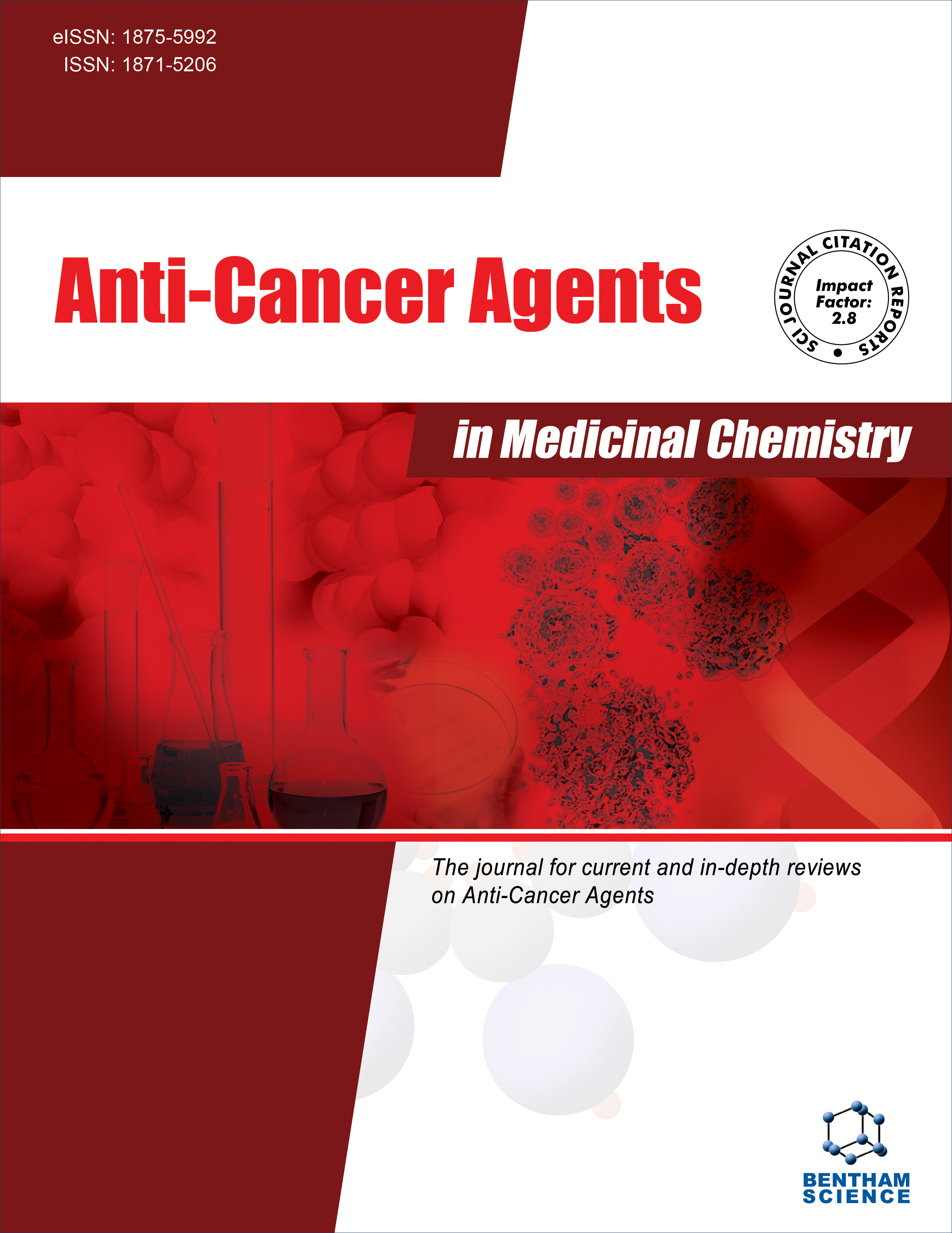- Home
- A-Z Publications
- Anti-Cancer Agents in Medicinal Chemistry (Formerly Current Medicinal Chemistry - Anti-Cancer Agents)
- Previous Issues
- Volume 23, Issue 2, 2023
Anti-Cancer Agents in Medicinal Chemistry (Formerly Current Medicinal Chemistry - Anti-Cancer Agents) - Volume 23, Issue 2, 2023
Volume 23, Issue 2, 2023
-
-
Amivantamab: A New Hope in Targeting Non-small Cell Lung Cancer
More LessAuthors: Koushal Billowria, Ghanshyam Das Gupta and Pooja A. ChawlaBackground: Amivantamab was approved on May 21st, 2021, by United States food and drug administration with the brand name Rybervant, used particularly for adult patients with exon20 insertion of epithelial growth factor receptor with locally advanced metastatic non-small cell lung cancer. Objective: In this review, we explain the non-small cell lung cancer and molecular distinctions between non-small cell lung cancer and s Read More
-
-
-
Recent Literature Review on Coumarin Hybrids as Potential Anticancer Agents
More LessCancer is considered one of the leading causes of death globally, especially patients with lung, pancreatic, or brain tumors are most likely to die of cancer, and patients with prostate and breast cancer are at a high risk of noncancer death. As a result, there is ongoing research regarding developing new, safe, and efficient anticancer agents. Coumarin-based naturally occurring compounds possess a broad spectrum of acti Read More
-
-
-
Recent Advancements in Organotin(IV) Complexes as Potent Cytotoxic Agents
More LessAuthors: Jai Devi, Ankit Boora, Manju Rani and Tanisha AroraBackground: Cancer cases have escalated by approximately 12% since 1900 and the incidence rate has increased faster for females than males. The discovery of cisplatin in 1965 paved the way for metal-based compounds as cancer therapeutics. Unfortunately, cisplatin and other platinum-based medicines cause severe side effects. Therefore, non-platinum metal complexes have been developed as alternate cancer drugs. Read More
-
-
-
Design, Synthesis, Docking Studies, Enzyme Inhibitory and Antiplatelet Aggregation Activities of New 1,3-Diphenyl-3-(Phenylthio)Propan-1-One Derivatives as Selective COX-2 Inhibitors
More LessAuthors: Maryam Bayanati, Bahram Daraei and Afshin ZarghiBackground: Cancer is the second leading cause of death worldwide after heart disease. A vast number of studies indicated that selective cyclooxygenase-2 (COX-2) inhibitors could be chemopreventive against different types of cancer because the expression of COX-2 is increased. Therefore, to develop new therapeutics for cancer, the design and synthesis of new COX-2 inhibitors with few side effects seem attractiv Read More
-
-
-
Berbamine Exerts an Anti-oncogenic Effect on Pancreatic Cancer by Regulating Wnt and DNA Damage-related Pathways
More LessAuthors: Bingren Hu, Yingnan Yang, Jinfu Tu, Huajie Cai, Shouzhang Yang, Xinwei Chen and Gang ChenObjective: This study aimed to determine the effects of berbamine on pancreatic cancer as well as the underlying mechanisms. Methods: The pancreatic cancer cells were treated with different concentrations of berbamine and then subjected to cell viability assay, colony formation assay, cell cycle analysis, and apoptosis detection. Western blotting and immunofluorescence analyses were performed to investigate the mec Read More
-
-
-
The Glutaminase Inhibitor Compound 968 Exhibits Potent In vitro and In vivo Anti-tumor Effects in Endometrial Cancer
More LessAuthors: Hui Guo, Wanhu Li, Guoyou Pan, Cong Wang, Dapeng Li, Naifu Liu, Xiugui Sheng and Lingqin YuanBackground: Glutamine is one of the primary nutrients utilized by cancer cells for energy production and biosynthesis. Hence, interfering with glutamine metabolism may impose anti-tumor effects. Objective: In this study, we assessed the anti-tumorigenic effects of glutaminase-1 enzyme (GLS1) inhibition in endometrial cancer in vitro and in vivo. Methods: The human endometrial cancer cell lines Ishikawa and HEC-1B wer Read More
-
-
-
Choosing the Right Protocol to Establish MCF-7 Tumor Xenograft in Nude Mice
More LessBackground: Xenografts of various human cancers in nude mice provide a helpful model in cancer research. This study aimed to develop a xenograft mouse model of MCF-7 breast cancer using injectable estradiol valerate. Methods: Thirty healthy female C57 nu/nu mice were engrafted with three protocols to establish an MCF-7 tumor. Injectable estradiol valerate (10 mg/ml) was used as a substitute for estradiol pellets. Read More
-
-
-
Tanshinone IIA Alleviates the Biological Characteristics of Colorectal Cancer via Activating the ROS/JNK Signaling Pathway
More LessAuthors: Jun Qian, Yi Cao, Junfeng Zhang, Lingchang Li, Juan Wu, Jialin Yu and Jiege HuoBackground: Tanshinone IIA (Tan IIA) exerts a significant inhibitory effect on various tumor cells since it induces cell apoptosis and affects the proliferation, differentiation, metastasis, and invasion of tumor cells. However, the mechanism underlying the antitumor activity of Tan IIA has not been totally elucidated. Objective: This study aimed to uncover the role of Tan IIA in colorectal cancer (CRC) and its potential mechanism Read More
-
-
-
New neo-Clerodane Diterpenoids Isolated from Ajuga decumbens Thunb., Planted at Pingtan Island of Fujian Province with the Potent Anticancer Activity
More LessAuthors: Olagoke Zacchaeus Olatunde, Jianping Yong and Canzhong LuAims: The aim of this study is to find the anticancer lead compounds or drug candidates from Chinese Traditional Plant Medicine of Ajuga decumbens Thunb. Background: Ajuga decumbens Thunb. has been used in clinical for a long time in China and was selected in “Chinses Pharmacopoeia” (part I in 1977) for its wide spectrum biological activities: such as anticancer, antioxidant, antifeedant, antibacterial, an Read More
-
Volumes & issues
-
Volume 25 (2025)
-
Volume 24 (2024)
-
Volume 23 (2023)
-
Volume 22 (2022)
-
Volume 21 (2021)
-
Volume 20 (2020)
-
Volume 19 (2019)
-
Volume 18 (2018)
-
Volume 17 (2017)
-
Volume 16 (2016)
-
Volume 15 (2015)
-
Volume 14 (2014)
-
Volume 13 (2013)
-
Volume 12 (2012)
-
Volume 11 (2011)
-
Volume 10 (2010)
-
Volume 9 (2009)
-
Volume 8 (2008)
-
Volume 7 (2007)
-
Volume 6 (2006)
Most Read This Month
Article
content/journals/acamc
Journal
10
5
false
en


